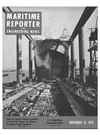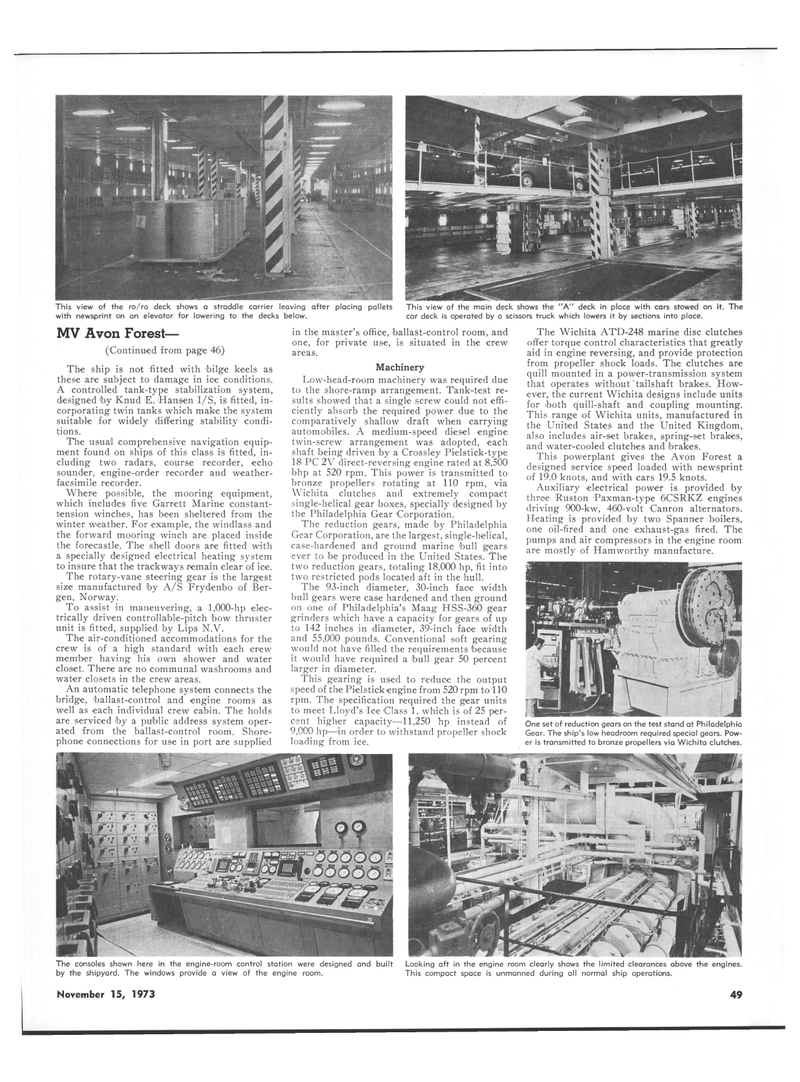
Page 43: of Maritime Reporter Magazine (November 15, 1973)
Read this page in Pdf, Flash or Html5 edition of November 15, 1973 Maritime Reporter Magazine
This view of the ro/ro deck shows o straddle carrier leaving after placing pallets This view of the main deck shows the "A" deck in place with cars stowed on it. The with newsprint on an elevator for lowering to the decks below. car deck is operated by a scissors truck which lowers it by sections into place.
MV Avon Forest— ('Continued from page 46)
The ship is not 'fitted with ibilge keels as these are subject to damage in ice conditions.
A controlled tank-type stabilization system, designed by Knud E. iHansen I/S, is fitted, in- corporating twin tanks which make the system suitable for widely differing stability condi- tions.
The usual comprehensive navigation equip- ment found on ships of this class is fitted, in- cluding two radars, course recorder, echo sounder, engine-order recorder and weather- facsimile recorder.
Where possible, the mooring equipment, which includes five Garrett Marine constant- tension winches, has been sheltered from the winter weather. For example, the windlass and the forward mooring winch are placed inside the forecastle. The shell doors are fitted with a specially designed electrical heating system to insure that the trackways remain clear of ice.
The rotary-vane steering gear is the largest size manufactured 'by A/S Frydenbo of Ber- gen, Norway.
To assist in maneuvering, a 1,000-hp elec- trically driven controllable-pitch bow thruster unit is fitted, supplied by Lips N.V.
The air-conditioned accommodations for the crew is of a high standard with each crew member having his own shower and water closet. There are no communal washrooms and water closets in the crew areas.
An automatic telephone system connects the bridge, ballast-control and engine rooms as well as each individual crew cabin. The holds are serviced by a public address system oper- ated from the ballast-control room. Shore- phone connections for use in port are supplied in the master's office, ballast-control room, and one, for private use, is situated in the crew areas.
Machinery
Low-head-room machinery was required due to the shore-ramp arrangement. Tank-test re- sults showed that a single screw could not effi- ciently absorb the required power due to the comparatively shallow draft when carrying automobiles. A medium-speed diesel engine twin-screw arrangement was adopted, each shaft being driven by a Crossley Pielstick-type 18 PC 2V direct-reversing engine rated at 8,500 bhp at 520 rpm. This power is transmitted to bronze propellers rotating at 110 rpm, via
Wichita clutches and extremely compact single-helical gear boxes, specially designed by the Philadelphia Gear Corporation.
The reduction gears, made by Philadelphia
Gear Corporation, are the largest, single-helical, case-hardened and ground marine 'bull gears ever to be produced in the United States. The two reduction gears, totaling 18,000 hp, fit into two restricted pods located aft in the hull.
The 93-inch diameter, 30-inch face width bull gears were case hardened and then ground on one of Philadelphia's Maag HSS-360 gear grinders which have a capacity for gears of up to 142 inches in diameter, 39-inch face width and 55,000 pounds. Conventional soft gearing would not have filled the requirements because it would have required a bull gear 50 percent larger in diameter.
This gearing is used to reduce the output speed of the Pielstickengine from 520 rpm to 110 rpm. The specification required the gear units to meet Lloyd's 'Ice Class 1, which is of 25 per- cent higher capacity—11,250 hp instead of 9,000 hp—in order to withstand propeller shock loading from ice.
The Wichita ATD-248 marine disc clutches offer torque control characteristics that greatly aid in engine reversing, and provide protection from propeller shock loads. The clutches are quill mounted in a power-transmission system that operates without'tailshaft brakes. How- ever, the current Wichita designs include units for both quill-shaft and coupling mounting.
This range of Wichita units, manufactured in the United States and the United Kingdom, also includes air-set brakes, spring-set brakes, and water-cooled clutches and brakes.
This powerplant gives the Avon Forest a designed service speed loaded with newsprint of 19.0 knots, and with cars 19.5 knots.
Auxiliary electrical power is provided by three Ruston Paxman-type 6CSRKZ engines driving 900-kw, 460-volt Canron alternators.
Heating is provided by two Spanner boilers, one oil-fired and one exhaust-gas fired. The pumps and air compressors in the engine room are mostly of Hamworthy manufacture.
One set of reduction gears on the test stand at Philadelphia
Gear. The ship's low headroom required special gears. Pow- er is transmitted to bronze propellers via Wichita clutches.
The consoles shown here in the engine-room control station were designed and built Looking aft in the engine room clearly shows the limited clearances above the engines, by the shipyard. The windows provide a view of the engine room. This compact space is unmanned during all normal ship operations.
November 15, 1973 49

 42
42

 44
44
